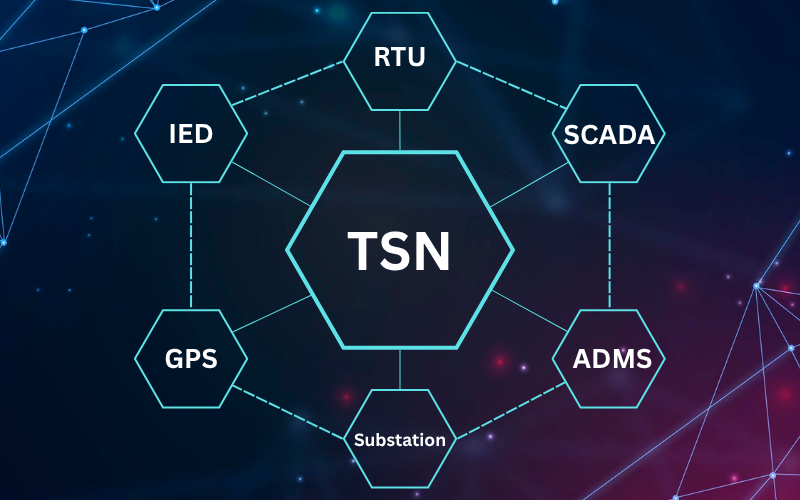
As
industrial automation and power systems evolve toward digital, decentralized,
and intelligent infrastructures, the demand for real-time, deterministic
communication grows exponentially. Traditional Ethernet lacks the precision
and reliability needed for mission-critical applications — that’s where Time-Sensitive
Networking (TSN) comes in.
TSN is
not just a buzzword. It's becoming the backbone of next-generation
substations and smart factories, offering precise synchronization,
ultra-low latency, and guaranteed data delivery.
What is TSN?
Time-Sensitive
Networking (TSN) is a
suite of IEEE 802.1 standards that enhances standard Ethernet with capabilities
for deterministic, time-critical communication. TSN ensures that
specific traffic — such as protection signals in substations or motion control
in a plant — gets delivered on time, every time, without delay, jitter,
or loss.
Why TSN is a Game-Changer for Substations
1.
Substation Automation (IEC 61850 Integration)
Substations
rely on protocols like GOOSE and Sampled Values (SV) to protect
equipment and maintain grid stability. These messages must be delivered within 2–4
milliseconds to ensure proper relay operation.
TSN
enables:
- Low-latency delivery of SV and GOOSE
messages.
- Redundant paths for high availability (IEEE
802.1CB).
- Sub-microsecond time
synchronization
with IEEE 802.1AS (aligns with IEC 61850-9-3).
- Seamless integration with Merging
Units, IEDs, and SCADA systems over a unified network.
TSN + IEC
61850 =
High-performance, future-proof digital substations.
Why TSN Matters in Industrial Automation
2. Precision, Speed, and Safety in Smart
Manufacturing
In
industrial environments, systems like robot arms, PLC controllers,
drives, and vision systems require deterministic data flows with microsecond
accuracy.
TSN
enables:
- Synchronized control across distributed devices
(crucial for motion control).
- Scheduled traffic using IEEE 802.1Qbv,
allowing time slots for real-time data.
- Mixed-criticality networks where control traffic
coexists with IT traffic.
- Future convergence of IT (TCP/IP) and OT
(fieldbus/real-time protocols).
This
transforms traditional segmented networks into a single converged Ethernet
network, reducing costs, complexity, and integration time.
Core TSN Features for Substation & Industrial Environments
|
TSN Feature |
Benefit in Substations |
Benefit in Industrial Automation |
|
IEEE
802.1AS (Time Sync) |
Aligns
Merging Units & IEDs |
Synchronizes
robots & sensors |
|
IEEE
802.1Qbv (Traffic Scheduling) |
Ensures
GOOSE/SV delivery |
Guarantees
motion command timing |
|
IEEE
802.1CB (Redundancy) |
Fault
tolerance for protection schemes |
High
availability for process control |
|
IEEE
802.1Qci (Stream Policing) |
Secure
and predictable flows |
Prevents
rogue traffic from affecting control loops |
Real-World Deployments
- Schneider Electric and ABB have started
integrating TSN into substation-grade switches and IEDs.
- Siemens and Bosch Rexroth are deploying TSN-enabled
PLCs and drives for synchronized multi-axis motion in smart factories.
- OPC UA over TSN is being adopted in both
power and industrial automation for unified, secure, and real-time data
exchange.
Challenges and Considerations
While the
advantages are clear, deploying TSN does involve challenges:
- Legacy system compatibility
- Complex engineering &
configuration
- Need for multi-vendor
interoperability
- Training for OT and IT teams
Organizations
must evaluate the TSN readiness of their network devices and plan a
phased migration strategy.
Conclusion: A Converged, Deterministic Future
Time-Sensitive
Networking bridges the gap between traditional real-time protocols and modern
Ethernet. For substations, it strengthens the IEC 61850 digital grid.
For industry, it powers deterministic control, paving the way for Industry
4.0.
Whether
you’re building a next-gen digital substation or a high-performance smart
factory, TSN is the enabler of real-time, future-ready automation.
Category: Substation
